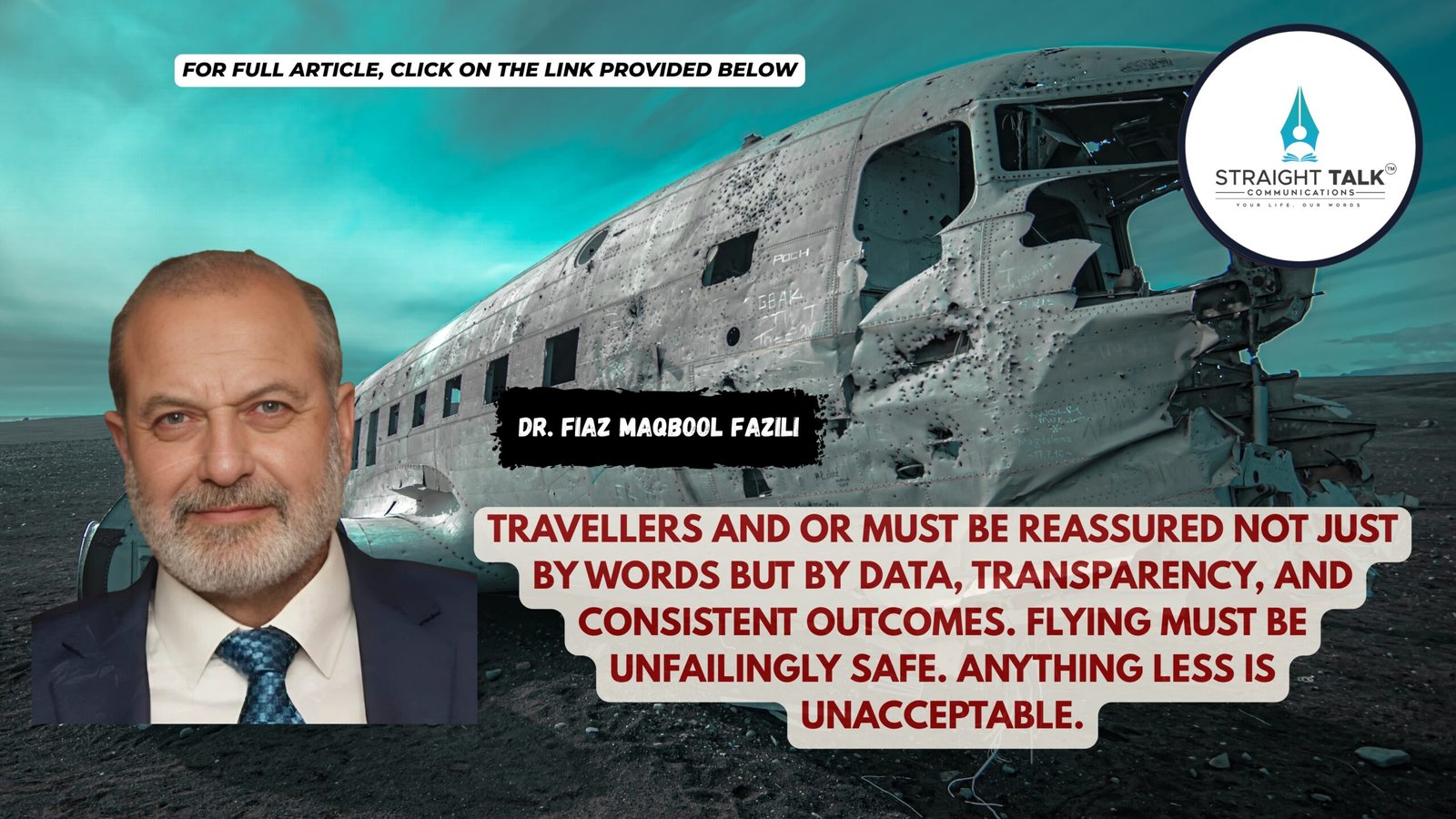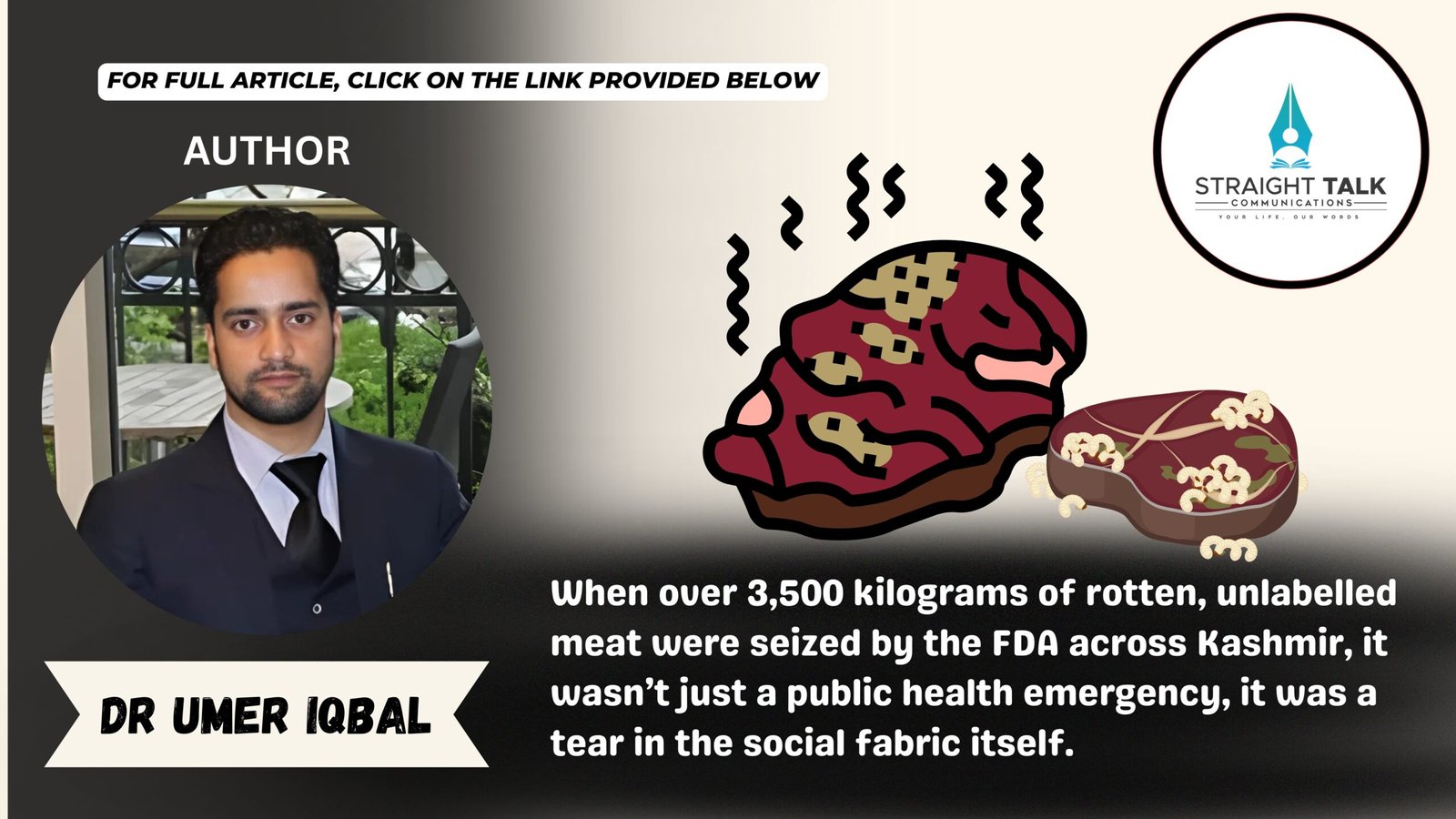Safety in Aviation is Not Optional but Mandatory: A Zero Tolerance Imperative

Travellers and or must be reassured not just by words but by data, transparency, and consistent outcomes. Flying must be unfailingly safe. Anything less is unacceptable.
DR. FIAZ MAQBOOL FAZILI
The aviation sector has revolutionized the way humanity connects, making the world more accessible than ever. However, this extraordinary convenience is counterbalanced by a fundamental responsibility—safety. With millions of lives depending daily on the efficiency and reliability of air travel, there is no room for compromise. The recent tragic crash near Ahmedabad has reignited public anxiety and raised critical questions about the state of aviation safety. Amid diverted, delayed, and cancelled domestic and international flights, passengers are asking: How safe is it to fly? The answer lies in reinforcing a foundational truth: Safety in aviation is not optional; it is mandatory. It must be governed by zero tolerance for negligence, errors—whether of omission, commission, or oversight. Anything less invites disaster.
A sobering reminder for safety-the crash near Ahmedabad, which led to multiple fatalities and widespread disruptions, was not just a statistical anomaly—it was a wake-up call. While aviation accidents remain relatively rare, their consequences are catastrophic. In the immediate aftermath of the crash, many flights were diverted mid-air, many were cancelled without adequate information, and safety protocols came under public scrutiny.Post air crash triggered significant operational responses—cancellations, diversions, and groundings—raising questions about whether this reflects hypervigilance or a renewed airline commitment to absolute safety. While these measures may seem extreme, they underscore an industry ethos that leaves zero room for error. Aviation remains statistically safer than road or sea transport, where risks demonstrably exceed those of flying. With thousands of aircraft airborne at any moment, the probability of an accident remains exceptionally low. This temporary disruption reaffirms, rather than undermines, aviation’s core priority: uncompromising safety for every passenger. “This incident serves to remind stakeholders—airlines, regulators, engineers, air traffic controllers, and policymakers—that there is no such thing as an “acceptable margin of error” in aviation. A single overlooked bolt, misread gauge, or delayed communication can result in irreparable loss.
Is the Reaction Hyper-Panic? Some observers have termed the reaction to the crash as “hyper-panic.” Airports were overcrowded, social media was flooded with fearful passengers demanding answers, and television coverage showed images of stranded travellers and grieving families. However, describing this response as hyperbolic overlooks a crucial fact: air travel is predicated on public trust. A breakdown in safety, real or perceived, undermines this trust and demands immediate accountability and transparency. Rather than viewing public concern as overreaction, it should be seen as a rational demand for transparency and responsibility. In sectors like aviation, even isolated incidents shake the entire ecosystem. Panic may be unavoidable at times, but vigilance is non-negotiable.
The Need for 100% Compliance- One of the strongest arguments emerging from this crisis is the demand for 100% compliance with safety standards—not 99%, not 99.9%, but 100%. Anything less opens the door to catastrophic failures. India, as one of the world’s fastest-growing aviation markets, must rise to this challenge with unwavering resolve. Regulatory bodies like the Directorate General of Civil Aviation (DGCA) must not only enforce rules strictly but also ensure that periodic audits, surprise checks, and systemic evaluations are conducted across all airlines, airports, and maintenance facilities. Airlines must invest in regular training, rigorous pre-flight checks, fatigue monitoring for crew, and cutting-edge safety technologies.
Safety should not be a reactive response to a tragedy; it must be proactive, predictive, and culturally embedded into the DNA of aviation operations. Role of IATA- The International Air Transport Association (IATA) plays a pivotal role in standardizing global aviation safety. Travellers’ concerns are legitimate-When a passenger boards a flight, they entrust their lives to the competence of pilots, the precision of engineers, the effectiveness of air traffic control, and the overall integrity of the aviation system. In return, they deserve more than assurances—they deserve proof. The recent disruptions have made people ask: Is it worth flying anymore? For business travellers, the unpredictability of flight schedules can lead to missed meetings, lost deals, and reputational harm. For medical patients, delays can be life-threatening. For families, the psychological toll of knowing something might go wrong mid-air is deeply unsettling. Airlines and regulators must understand that in the age of real-time communication, public trust is built—or destroyed—in seconds. The only antidote is consistent performance backed by uncompromised safety.
Technological and human factors are a dual challenge-While aviation has made leaps in technology—autopilot systems, advanced avionics, and AI-based maintenance predictions—human error remains a leading cause of aviation accidents. Pilot fatigue, miscommunication, poor judgment, and managerial shortcuts can all unravel even the most technologically sound systems. Countries must invest in human factor training, scenario-based simulations, and mental health support for aviation personnel. Equally, automated systems must be cross-verified through redundant mechanisms to ensure a safety net exists for every stage of flight—from ground operations to landing.
Aviation safety is a trust. Flight Aware reports an average of 12,000 to 14,000 commercial airplanes in the sky at any given time. There is an average of 9,728 planes carrying 1,270,406 passengers in the sky at any given time. No other mode of transport matches this. statistically, the chances of an airplane crash are significantly lower than those of Road Traffic Accidents (RTA). Chances of dying in a car accident: ~1 in 8,000 (lifetime). Annual global deaths: ~1.3 million (WHO). Comparison: You’re 100x more likely to die in a car crash than in a plane crash. Ferry Capsizing-Less common globally but more dangerous in developing countries with poor maritime safety. Comparison: The risk in certain regions can be 10–50x higher than flying. Medical Errors-Third leading cause of death in the US, after heart disease and cancer (per Johns Hopkins study). Est. deaths per year globally: Over 2.6 million. Odds of dying due to medical error (lifetime): ~1 in 5,000. Comparison: Medical error is over 100x more likely to kill than an airplane crash. Air Travel (Commercial Jet)-Odds of a fatal accident (per flight): ~1 in 11 million. Accident rate (IATA 2023): 0.80 per million flights. Fatal accident rate: 0.16 per million flights (1 fatal crash in 6.2 million flights).Chances of dying in a plane crash: ~1 in 11–20 million. Commercial aviation is one of the safest forms of transport. Flying is not hyper-panic. It’s hyper-safe. Despite rare, high-profile air crashes, statistically: “You’re more likely to die driving to the airport or due to a hospital error than flying on a commercial jet
Culture of Safety: Not Just a Slogan-Safety cannot be an abstract principle mentioned in mission statements. It must translate into daily operational discipline. Airline CEOs must be held directly accountable for failures. Whistleblowers must be protected and rewarded. Maintenance workers must be empowered to halt a flight if they detect a fault. Safety officers must have a seat at top-level management. What the aviation sector needs is reassurance to passengers and a culture of “safety-first, profit-second”—a paradigm shift that puts human life before ticket sales.
Key take away: Zero Tolerance, Infinite Vigilance-The phrase “zero tolerance” in aviation is not hyperbole—it is an operational requirement. Pending RCA root cause analysis professional conclusion on inquiry the Ahmedabad crash was not just a tragedy; it was a reminder that whether even one error is one too many. Whether it’s a loose screw or a scheduling miscommunication, the stakes are too high to ignore. The Indian aviation industry, supported by global partners like IATA, always works toward 100% safety compliance as an Essential Safety Requirement (ESR). Travellers and or must be reassured not just by words but by data, transparency, and consistent outcomes. Flying must not only be fast and affordable—it must be unfailingly safe. Anything less is unacceptable.







